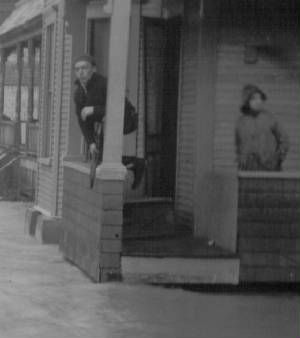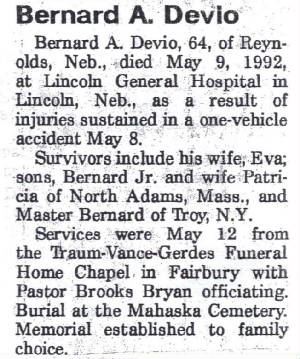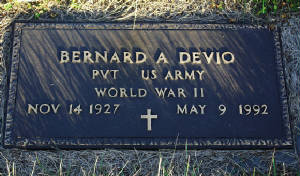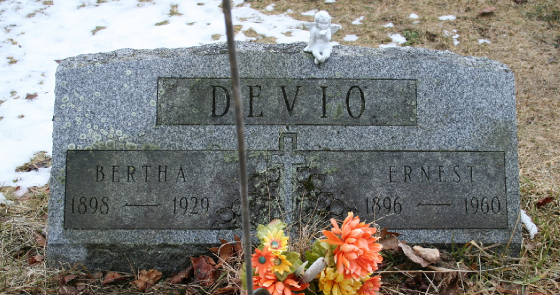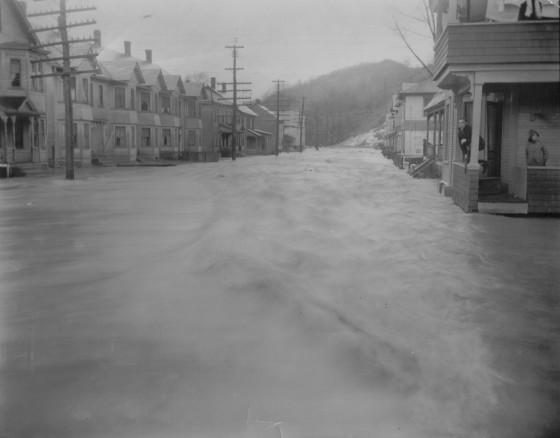
On Nov 2, 1927, the afternoon sky grew ominously dark as residents of River Street received the daily North Adams Transcript. Thirty-six hours later, over six inches of soaking rain had fallen, carrying a few tenement houses into the raging water. The Marshall Street bridge broke free and slammed into the Brown Street bridge. Anthony Talarico, who passed away in 2001, told me that he witnessed the devastation when he was 13 years old.
“There were about three tenement blocks right after Harris Street. The water began to eat away at the first tenement block. All the people in the houses put planks from one tenement block to the other and crossed over to the center of the middle tenement. The fire department came over and put a ladder across River Street, which was like a rushing torrent. People were screaming. I can still hear it.”
Eighty-three years later, I received a letter from a woman in Shelburne, Vermont, whose grandparents lived in North Adams up until the 1970s. She told me that she had read one of my books about the city. She enclosed a well-preserved photograph and told me I could keep it. On the back was written, “1927, River Street looking west, North Adams flood.” It showed a man and woman on the porch of a house, watching the water pour down the street with great force.
My first reaction was that I wanted to make the one-hour drive to North Adams right away and find the exact spot, perhaps even the original house. I stared at the picture for quite a while, and then it suddenly dawned on me, “Why not try something a little more challenging, like identifying the people in the picture?”
But how does one go about doing that? I thought to myself: “If I can find out the address of the house, I can look up that address in the 1927 city directory and see who was living there.” Several days later, over breakfast with my North Adams friend Carl Robare, we examined the picture, and Carl said he thought the house might be at the bottom of Harris Street, where it intersects with River Street. I drove over there, but the house looked quite a bit different, so I wasn’t sure.
The next day, Carl called and said that he had gone to the North Adams Public Library and examined the city map from 1904, and he was still pretty sure of his first guess. Back in town two days later, I went to the library and showed the picture to staff members Robin Martin and Katharine Westwood. Robin said: “I can see in the photograph that there isn’t a house in the foreground next to the house with the people on the porch, just a large space. So there must have been a street coming down from the hill, probably Harris.”
I looked in the 1927 city directory, and the house on that corner was 385 River Street. The only occupant listed was Samuel Giulino, and presumably his unnamed family members. When I got home, I found the family in the 1920 census, living at a different address: 18 Waverly Place. There was Samuel, age 32; his wife (spelled Philiphino), also 32; and five children. In the 1930 census, Samuel was not listed, but his wife (listed as Josephine this time) and the kids were living at 385 River Street. She owned the house. So at that point, it seemed likely that the two people were Mr. and Mrs. Giulino…except for one thing: Both of them would have been about 39 years old in 1927, and the man and woman in the photo looked much younger. That bothered me. So did the article which I found the next day in the December 19, 1932 edition of the North Adams Transcript:
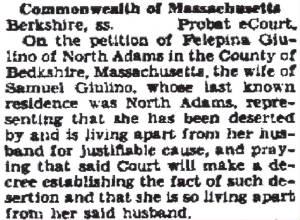
This explained why Samuel wasn’t listed with her in the 1930 census. I wondered if they had been separated as far back as 1927, at the time of the flood. If so, it was even more likely that the couple in the photo was not them. I proceeded with my research with that in mind. Perhaps there was another family living in the house, in a separate apartment.
Meanwhile, I headed for 385 River Street, with my camera and a copy of the photo. The house is at the bottom of Harris Street, just west of the intersection. The North Adams Ambulance Service is on the east side of the intersection, and has a big parking lot in front of it. I stood in the lot and placed the photo on the ground. I had to put a rock on it to keep it from blowing away. I knew immediately that I was in the right spot.
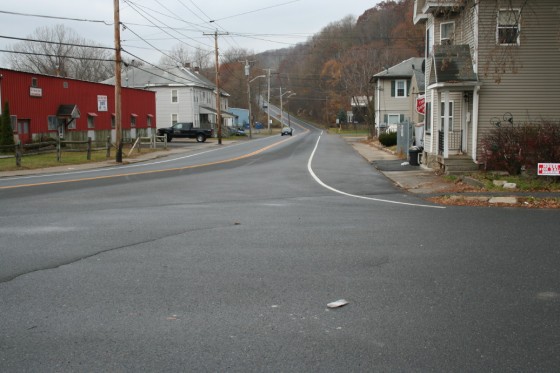
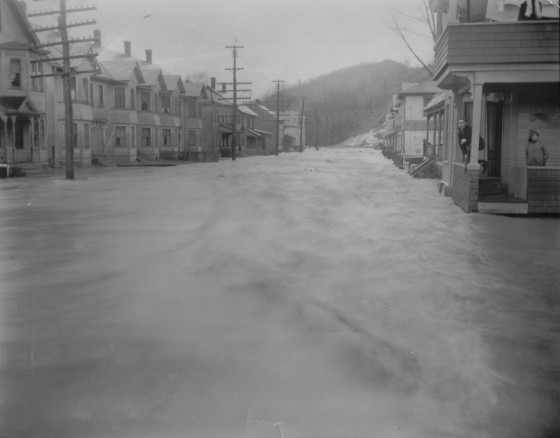
The house had been remodeled. Everything west of the house looked familiar, though many of the multi-family houses along the south side of River Street are no longer there. But I knew that many of them had been torn down in the 1950s. The two houses that are still there look exactly the same. So does the house two doors down from 385 River Street. The one in between is gone, and the Salvation Army stands in its place.
Right after I took a few pictures, a lady walked out of the house and headed up River Street. I said hello, showed her the photo, and told her it was taken in 1927. “Wow,” she said. “That’s the same house. I remember when it looked like that, before it was remodeled. They took off the porch.”
I have access to the searchable digital archives of the Transcript, which appear on Ancestry.com. When I got home, thinking that there might be an article about the flood that mentioned the house, I entered “385 River Street” in the search box. I couldn’t believe my eyes. This appeared on November 19, 1927, 16 days after the flood:

I was convinced, perhaps prematurely, that it was Ernest and Bertha who were standing on the porch. Bertha was “very pregnant” that day. So I tried an experiment. I blew up the photo and showed it to my wife. I asked her, “What do you see in this picture? How old do they look? What else do you notice?” She estimated their ages at about 30. And then she said, “The woman looks pregnant. Her coat is pretty big around her.”
I looked them up in the census. In 1920, Ernest (23) and Bertha (21) were married and living at 16 Adams St, just a block from 385 River St. They had no children. That would mean that in 1927, they were about 30 and 28, the age range that my wife had estimated. I was satisfied that I had identified them. Then I found this in the Transcript, published on March 27, 1929. I was stunned.

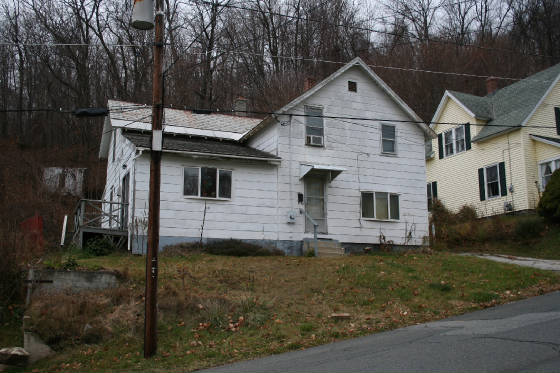
In the 1930 census, Ernest, now widowed, was living with his widowed mother, at 19 Tyler St, along with his three children, Leonard (10), Dorothy (5), and Bernard (2). I also found Ernest’s 1918 draft registration. He was listed as single, living with his parents at 19 Tyler St, and working at the Hoosac Cotton Mill on Union Street. Knowing all this, I looked at the photograph again, and a scenario played out in my mind.
Ernest and Bertha married about 1919. A year later, now living on Adams St, they had their first child, Leonard. In 1925, Dorothy was born. Several months into 1927, Bertha became pregnant again. Around that time, they were renting an apartment at 385 River Street, from the Giulino family, who lived in a second apartment.
On November 2, the rains came. Bertha was near term with Bernard. Their two children were seven and two. Within 24 hours, the Hoosac River spilled over its banks. As the water got higher and higher on River Street, Ernest and Bertha became more and more concerned. Leaving their children safely inside the house, they stepped out on the porch and stared at the scene, perhaps looking for somebody to rescue them. Someone, maybe a newspaper reporter, took their picture. Soon after, they were rescued. Once again, Anthony Talarico’s vivid memories:
“There were about three tenement blocks right after Harris Street. The water began to eat away at the first tenement block. All the people in the houses put planks from one tenement block to the other and crossed over to the center of the middle tenement. The fire department came over and put a ladder across River Street, which was like a rushing torrent. People were screaming. I can still hear it.”
Unable to return to their house right away, Ernest and his family probably have found shelter at his mother’s house on Tyler Street, which was on higher ground. But as Bertha’s obituary indicates, they eventually wound up with Bertha’s father, in Philmont, New York. That’s where she passed away less than two years later. Ernest and his three children returned to North Adams and lived with his mother.
**************************
Ernest Devio was born in North Adams on February 2, 1896, one of about 20 children born to Onesime and Mary Lanoue Devio. Onesime, a mill worker, died in 1925. Mary died in 1958. Ernest did not remarry. He died in Florida on January 7, 1960, at the age of 63. Bertha was born in Adams, Massachusetts in 1898, the first child of John and Julia Nimmons.

Their first child, Leonard, died in Florida in 1986, at the age of 66. He never married. Dorothy married James Andrews and died in Florida in 1980, at the age of 55. Bernard, who was born 11 days after the flood, worked for a while for the gas company in North Adams. He married Leona O’Dell in the city in 1953. In 1972, he married Eva (last name unknown) in Texas. He died in Reynolds, Nebraska on May 9, 1992, at the age of 64. He had three children, none of whom I could locate.
The only descendants I was able to contact were two of Ernest’s nieces, but both of them barely remember him. Perhaps the only photograph of Ernest and Bertha that still exists in the one I have.
